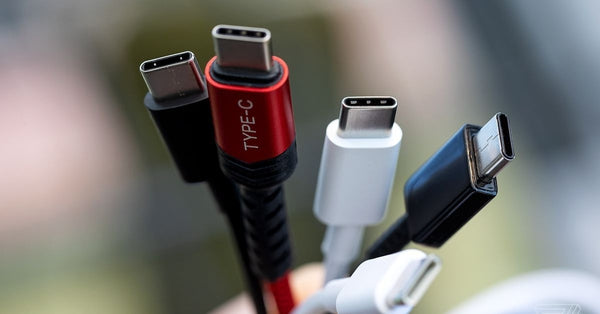On All U.S. Orders $50+

EU proposes mandatory USB-C on all devices, including iPhones - The Verge
The European Commission, the executive arm of the European Union, has announced plans to force smartphone and other electronics manufacturers to fit a common USB-C charging port on their devices. The proposal is likely to have the biggest impact on Apple, which continues to use its proprietary Lightning connector rather than the USB-C connector adopted by most of its competitors. The rules are intended to cut down on electronic waste by allowing people to re-use existing chargers and cables when they buy new electronics.
In addition to phones, the rules will apply to other devices like tablets, headphones, portable speakers, videogame consoles, and cameras. Manufacturers will also be forced to make their fast-charging standards interoperable, and to provide information to customers about what charging standards their device supports. Under the proposal, customers will be able to buy new devices without an included charger.
The proposals only cover devices using wired, not wireless, chargers, EU commissioner Thierry Breton said in a press conference, adding that “there is plenty of room for innovation on wireless.” A spokesperson for the Commission subsequently confirmed to The Verge that a USB-C port is only mandatory for devices that charge using a cable. But, if a device charges exclusively via wireless, like Apple’s rumored portless iPhone, there’d be no requirement for a USB-C charging port.
To become law, the revised Radio Equipment Directive proposal will need to pass a vote in the European Parliament. If adopted, manufacturers will eventually have 24 months to comply with the new rules. The parliament has already voted in favor of new rules on a common charger in early 2020, indicating that today’s proposal should have broad support.
“Chargers power all our most essential electronic devices. With more and more devices, more and more chargers are sold that are not interchangeable or not necessary. We are putting an end to that,” said commissioner Thierry Breton. “With our proposal, European consumers will be able to use a single charger for all their portable electronics – an important step to increase convenience and reduce waste.”
“European consumers were frustrated long enough about incompatible chargers piling up in their drawers. We gave industry plenty of time to come up with their own solutions, now time is ripe for legislative action for a common charger,” European Commission executive vice-president Margrethe Vestager said.
Are your chargers piling up in a drawer?
We propose a common charger for mobile phones and other similar electronic devices.
A single charger will be more convenient for people and will reduce electronic waste.
Read more: https://t.co/hkspfjwlhu #DigitalEU pic.twitter.com/ZhWZ8xSGKH
Today’s proposal is focused on the charging port on the device end, but the Commission says it eventually hopes to ensure “full interoperability” on both ends of the cable. The power supply end will be addressed in a review to be launched later this year.
The proposals follow a vote in the European Parliament in January 2020 when lawmakers voted for new rules on common chargers. As of 2016, the amount of electronic waste produced across the bloc amounted to around 12.3 million metric tons.
The biggest impact of the new rules is likely to be felt by Apple, which continues to ship phones with a Lightning connector as opposed to the increasingly universal USB-C port. As of 2018, around 29 percent of phone chargers sold in the EU used USB-C, 21 percent used Lightning, and around half used the older Micro USB standard, according to an EU assessment reported by Reuters. These proportions are likely to have shifted considerably as USB-C has replaced Micro USB across all but the least expensive Android phones.
Efforts to get smartphone manufacturers to use the same charging standard in the EU date back to at least 2009, when Apple, Samsung, Huawei, and Nokia signed a voluntary agreement to use a common standard. In the following years, the industry gradually adopted Micro USB and, more recently, USB-C as a common charging port. However, despite reducing the amount of charging standards from over 30 down to just three (Micro USB, USB-C, and Lightning), regulators have said this voluntary approach has fallen short of its objectives.
Apple was a notable outlier in that it never included a Micro USB port on its phones directly. Instead, it offered a Micro USB to 30-pin adapter.
Apple said it disagreed with today’s proposals in a statement. “We remain concerned that strict regulation mandating just one type of connector stifles innovation rather than encouraging it, which in turn will harm consumers in Europe and around the world,” a spokesperson from the company told Reuters. The company has also previously objected to the proposals because it says they risk creating e-waste by forcing people to throw out their existing Lightning accessories if they’re incompatible with the universal standard.
Although it’s continued to use Lightning, Apple has made its own efforts to reduce charger e-waste. Last year, it stopped shipping charging bricks or earbuds in the box with new iPhones and supplied them only with a Lightning to USB-C cable. However, the move was met with a mixed response, with some arguing that it helped Apple’s bottom line more than the environment.
While European lawmakers focus mainly on wired chargers, wireless charging is becoming increasingly popular across smartphones and has largely converged on a single cross-platform standard: Qi. There have even been rumors that Apple could ship an iPhone without a Lightning port and have it rely entirely on wireless charging for power.
Update Septeber 23rd, 9:22AM ET: Updated to note Breton’s comments about wireless chargers from Q&A, and confirmation that a completely wireless phone would not need to include USB-C. Also added comment from Apple.
This content was originally published here.



Leave a comment